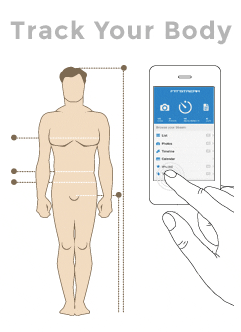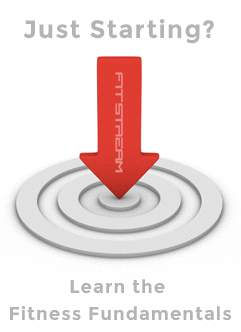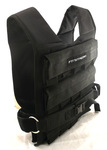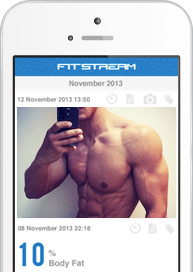While the overall symmetry and proportion of our bodies is largely determined by genetics, we can, through properly applied training, control our overall body shape.
Keeping a health journal, taking measurements and recording body changes over time is an important part of your training. It builds motivation, shows what progress you’re making, is useful for goal setting and can help you make insightful judgements about what works (and doesn’t) for you.
This simple article lays out everything you need to start taking body measurements today.
All you need to use is a body measurement tape (these are usually made of plastic or fabric and are flexible so are able to contour to the body). The Fitstream tape is pictured below and available to buy in our store;

Body Measurements Tips
- Generally, take measurements in an unflexed state and before your workout, not after!
- Keep the feet together, relax your muscles and stand up straight.
- Consistency is essential - measure under the same conditions and using the same equipment each time.
- Pull the tape tight, keeping pressure against (but not pinching) the skin and ensure the tape is kept level and not at an angle.
- To make sure the tape is positioned correctly, ideally, get someone else to take the measurements for you. If this isn’t possible take the measurements yourself in front of a mirror for better visibility.
- Measure both sides of the body to accurately track progress and symmetry.
- Always measure on bare skin and not over clothing.
What body parts to measure
What measurements you should take will depend on your personal goals but we’ve compiled this list of the most common measurements to record.
- Bicep / upper arm (left and right)
- Calf (left and right)
- Chest
- Forearm (left and right)
- Hips
- Neck
- Shoulders
- Thigh (left and right)
- Waist
Measuring the biceps
Measure the biceps at its largest girth. The measurement can in a few different states;
- Relaxed with arms at the sides
- Relaxed with arm bent
- Flexed with arm bent

Measuring the calf muscle
If you’re measuring yourself, do so in a seated position, or preferably, if you have a partner, stay standing and take the measurement at the widest point of the calf.

Measuring the chest
Whilst standing, measure in an exhaled state, just above the nipples.

Measuring the forearm
Measure at the thickest point of the forearm, below the elbow.

Measuring the hips
Measure at the largest point around the butt.

Measuring the neck
Whilst standing, measure around the neck at the largest point, over the Adam’s apple (if you have one!).

Measuring the shoulders
In a standing position, you can either measure as a straight line from the largest points on each shoulder across the chest or as a girth measurement all the way around the body.
It's best to use a partner to help take the shoulder measurement.

Measuring the thigh
Whilst standing, measure at the widest point of the upper leg, just below the butt to capture the thigh measurement.

Measuring the waist
In a standing position, measure at the narrowest point or at the midway position between the top of the hip bone and bottom of the rib cage.

Where to Record Your Body Measurements
Many people use a paper journal to record progress which works perfectly fine but there are many benefits to using a digital journal that may tempt you away;
- Easy to search journal records
- Ability to analyse and report on health and fitness progress
- Infinite record keeping in a single place
- Ability to see snapshot views into changes (e.g. average, highest and lowest measurement values in a time period)
- Collaboration with other people pursuing the same goals
- Data is securely backed up and can’t be lost like a paper journal
- Data is private and can’t be viewed by others
We’ve built the perfect platform for journalling your health and fitness progress and recording those bodymetrics. Fitstream was purpose-built, from the ground up for this very concept and has helped thousands of people around the world to track, understand and change their bodies.
Checkout the Livestream to see what our community are publically recording and download the Fitstream iPhone app to start tracking today for free.
How often to take body measurements
When it comes to taking body measurements there’s no need for daily tracking as physical changes generally don’t change on a day-to-day basis. We recommend taking weekly body logs, measured at the same time of day and under the same conditions. This approach will be enough to see how you’re changing over time and gauge trends.
Tip: Make sure that you set a weekly reminder to take the measurements so that you don’t forget and you build up the habit over time.
Use your data to set goals
Now that you’re regularly journaling and recording body measurements it’s time to look at the data. Explore your records and decide on your health and fitness goals. Then it’s simply a case of working out a plan on how to transform your body based on those goals.
We have an article coming soon on theories of the perfectly proportioned physique to help you set those goals.
Going beyond body measurements
Whilst this article is focused on taking body measurements, you should also consider recording other information for a complete picture of health and to create a hugely powerful body timeline;
- Progress pic tracking of your physique to track visually
- Track changes in body weight
- Record Body fat levels
Recording measurements alone will tell you where you’re changing but you still won’t have insight into what kinds of changes are taking place, and of the body composition. Are you building muscle of putting on fat? To determine this you need to track your body fat percentage and can read about this in our guide to measuring body fat.
Happy tracking! Let’s see how you measure up; and get started with Fitstream today.











